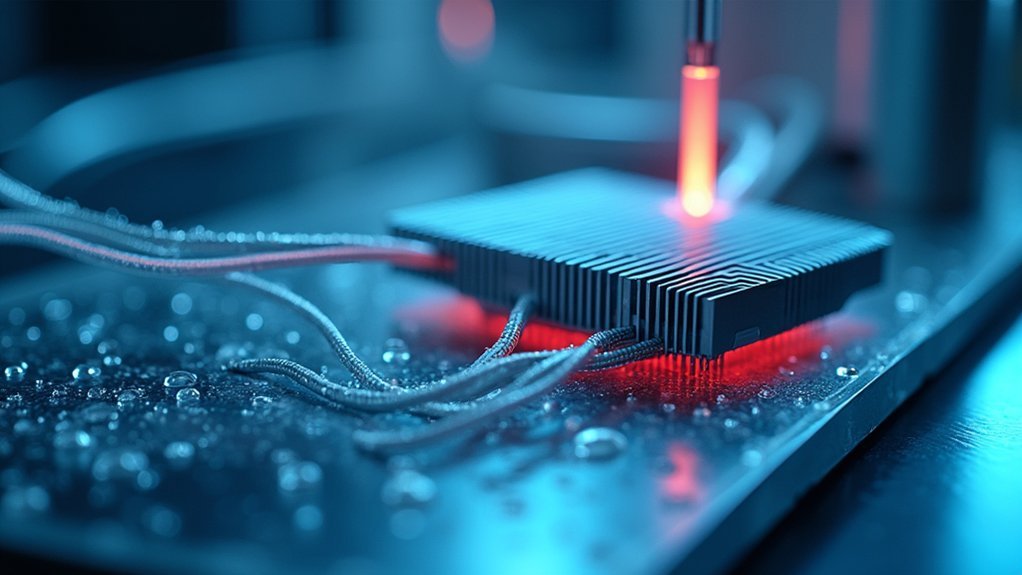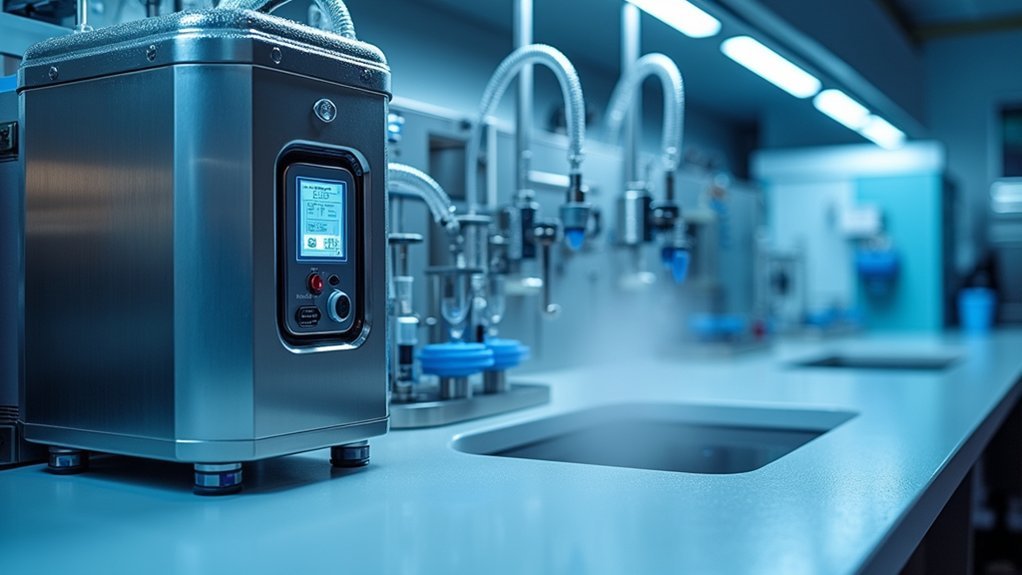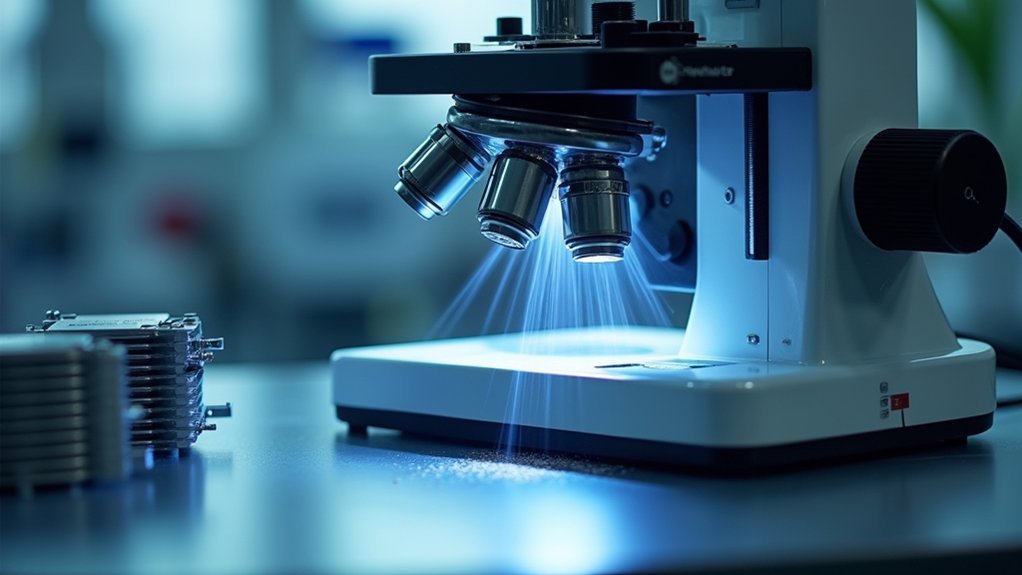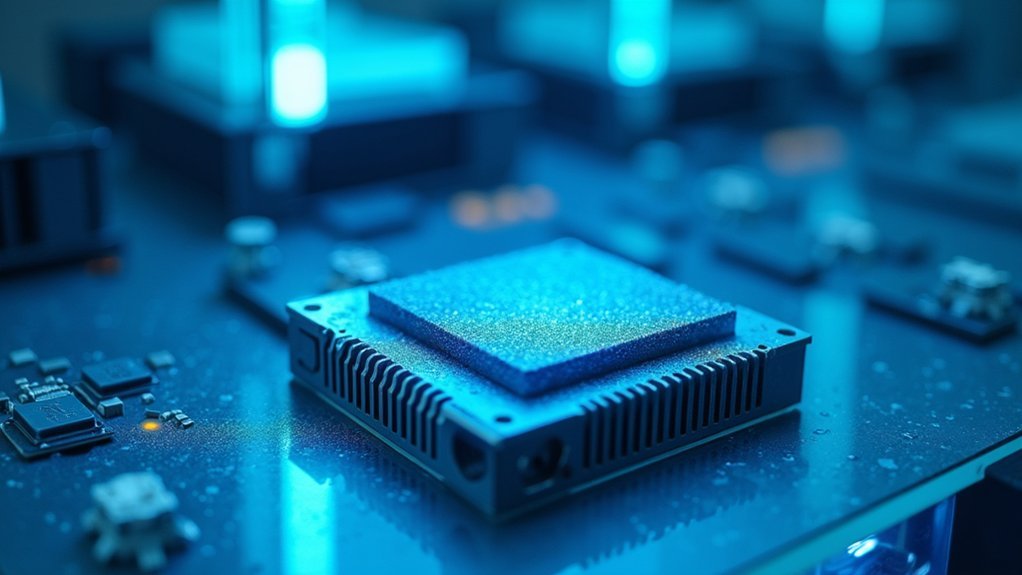For ideal lab imaging results, maintain sensor temperatures within ±0.1°C stability range. Match your chiller’s cooling capacity to specific sensor requirements (CCD at -20°C, CMOS between -10°C and 25°C). Perform weekly coolant checks and monthly filter cleaning to prevent system degradation. Choose between air or water-cooled configurations based on your lab setup. Store unused sensors in climate-controlled environments. The following tips will transform your imaging precision while extending equipment life.
5 Best Sensor Cooling Tips For Lab Imaging

When conducting precision lab imaging, maintaining stable sensor temperatures isn’t just good practice—it’s essential for reliable results. For peak performance, aim for temperature stability of ±0.1°C every time you run imaging procedures.
Consider investing in compact recirculating chillers that offer both heating and cooling capacities tailored to your specific temperature requirements. These systems are particularly valuable when dealing with space constraints in crowded lab environments.
Space-efficient recirculating chillers with dual temperature control capabilities prove invaluable in today’s compact laboratory settings.
Rack mount chillers provide an excellent solution for cooling multiple sensors while maximizing available workspace.
Monitor coolant temperature and flow rates regularly to prevent sensor damage. Implementing pressure and flow sensors enables real-time system monitoring, helping you quickly identify potential issues before they affect your imaging results.
This proactive approach guarantees your sensitive equipment maintains consistent operating conditions throughout extended imaging sessions.
Optimal Temperature Ranges for Different Imaging Sensors
Now that you’ve established reliable cooling systems for your lab, understanding the specific temperature requirements for each sensor type will maximize your imaging results.
Different sensors perform best within specific temperature ranges, greatly affecting your final image quality.
For peak performance, maintain your sensors within these ranges:
- General imaging sensors: 0°C to 30°C to prevent noise and maintain sensitivity
- CCD sensors: Around -20°C to minimize dark current and enhance dynamic range
- CMOS sensors: Between -10°C and 25°C for best signal-to-noise ratios
- Precision applications: Use compact chillers with ±0.1°C stability
Remember to continuously monitor your sensor temperatures, as deviations can accelerate component degradation.
Your cooling strategy should accommodate these specific ranges while maintaining the stability required for consistent, high-quality imaging results.
Selecting the Right Chiller System for Your Lab Equipment

Choosing the appropriate chiller system represents a critical decision that directly impacts your imaging results and equipment longevity. When evaluating options, focus on temperature stability—compact models maintain ±0.1°C precision within 10-35°C ranges, essential for consistent imaging quality.
Match the cooling capacity to your specific equipment needs by selecting from eight available capacity levels. You’ll need to decide between air-cooled or water-cooled configurations based on your lab’s existing infrastructure.
| System Type | Temperature Stability | Best Application |
|---|---|---|
| Compact Air-Cooled | ±0.1°C | Limited space labs |
| Water-Cooled | ±0.1°C | High-heat environments |
| Rack Mount (19″) | ±0.1°C | Integrated setups |
| Global Power Compatible | ±0.1°C | International facilities |
Don’t overlook power supply compatibility—many modern chillers accommodate global power variations, ensuring your system works reliably regardless of location.
Preventative Maintenance for Cooling System Longevity
To maximize the lifespan of your lab imaging equipment, regular maintenance of cooling systems isn’t just recommended—it’s essential. Proper upkeep guarantees your sensors operate within the critical 10-35°C range, preventing performance degradation and costly repairs.
Implement these key maintenance practices:
- Check coolant levels weekly – Always use the appropriate coolant solution specified for your imaging sensors.
- Clean filters and heat exchangers monthly – Remove debris that could restrict airflow and reduce cooling efficiency.
- Inspect flow and pressure sensors quarterly – Guarantee stable coolant circulation throughout the system.
- Monitor temperature stability daily – Record fluctuations that might indicate developing issues.
When not in use, store your sensors in climate-controlled environments to extend their lifespan and maintain calibration accuracy between imaging sessions.
Managing Heat Dissipation in High-Resolution Microscopy

While preventative maintenance addresses general cooling needs, high-resolution microscopy presents unique thermal challenges. Your imaging quality depends directly on maintaining temperature stability within a 10-35°C range, with variations no greater than ±0.1°C to prevent artifacts in your results.
Consider implementing compact recirculating chillers for your setup—they’ll effectively manage heat during extended imaging sessions while preserving sensor integrity. Choose between air or water-cooled refrigeration circuits based on your lab’s specific requirements and space constraints.
Don’t overlook the importance of monitoring coolant flow rates and pressure stability during operation. Regular checks guarantee ideal heat dissipation performance, particularly during demanding high-resolution work.
With proper thermal management, you’ll maximize both image quality and the lifespan of your sensitive microscopy equipment.
Frequently Asked Questions
How Do Power Outages Affect Cooled Sensor Recovery Time?
Power outages interrupt your sensor’s cooling cycle, forcing a complete restart. You’ll face extended recovery times as the system must gradually re-cool from ambient temperature, which can add hours to normal operations.
Can Sensor Cooling Systems Work Effectively in High Humidity Environments?
You’ll need dehumidifiers in high humidity environments. Moisture can condense on cooled sensors, causing damage and performance issues. Consider sealed enclosures and desiccants to protect your cooling systems from humidity-related problems.
Are Liquid Nitrogen Cooling Systems Worth the Additional Safety Protocols?
Yes, liquid nitrogen cooling systems are worth the safety protocols when you need extremely low temperatures. You’ll get superior noise reduction and sensitivity for critical imaging applications that justify the handling precautions.
How Often Should Thermal Interface Materials Be Replaced?
You should replace thermal interface materials every 6-12 months in active systems. Don’t wait for temperature fluctuations to signal problems. High-end imaging setups might need more frequent replacements when operating at maximum cooling capacities.
Do Vibrations From Cooling Systems Affect Imaging Resolution?
Yes, vibrations from cooling systems can reduce your imaging resolution. You’ll need to isolate cooling equipment, use vibration-dampening mounts, or switch to passive cooling solutions when conducting high-resolution microscopy work.
In Summary
You’ll notice improved image quality and extended equipment life when you properly manage sensor cooling. Don’t neglect regular maintenance checks on your cooling systems, and always match your chiller to your specific imaging requirements. By maintaining ideal temperature ranges and addressing heat dissipation effectively, you’re protecting your investment while ensuring consistent, high-quality research results from your lab imaging equipment.





Leave a Reply